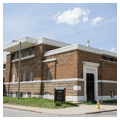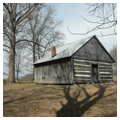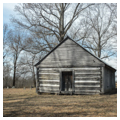In 1900, the African Methodist Episcopal (AME) Church published the Manual of the AME Church Extension Department, which detailed the church’s concerns over funding suitable houses of worship across its Connection. In addition to forming this department, founded in 1892 and dedicated to the acquisition of property and construction of church buildings, the AME Church also incorporated rhetoric within its manuals on doctrine and discipline on the proper dedication of new and restored church buildings. During this period, some of the AME leadership voiced concerns over the proper design of church buildings for adequate worship and mused the possibility of adding architectural studies to the pastorate training. In 1908 and 1912, the church further consolidated its building authority with the appointment of its own supervising architect, John Anderson Lankford, a Black architect known mostly for his work in Washington, D.C., but who also designed churches for AME missionaries in South Africa. The codification of these building procedures by the end of the nineteenth century demonstrates one way in which the AME Church confronted economic and social challenges facing Black communities in the wake of contradictions present in American identity that limited most racialized groups, especially when it came to how, where, and why someone builds.
Although the AME Church’s building campaign became a recognizable force toward the latter half of the nineteenth century, the church leadership’s preoccupation with property ownership and building began before the church’s official founding in 1816, when Black community leaders in northern cities, most notably Philadelphia, sought their own separate places of worship due to discrimination in White-dominated Methodist societies in the late eighteenth century. Thus began the building culture of the AME Church, reflecting a built environment that had been altered and marred by the legacy of slavery, discrimination, and perceptions of Blackness in the United States. It is important to note that there is no specific architectural style that defines the AME Church, but rather historical and cultural events that shaped the church’s built environment to create an index of category of American architecture.
Roots of Building Culture in the AME Church, 1790s–1850sAfter experiencing racial discrimination at St. George’s Methodist Church in Philadelphia in the 1790s, Richard Allen, the founder and first bishop of the AME Church, began his quest to erect a separate place of worship for the city’s Black community. Allen laments in his autobiography the discrimination the Black Methodists faced at St. George’s even after the Black parishioners helped to rebuild sections of the church. Allen eventually purchased two properties, one for the future St. Thomas Episcopal Church, of which Absalom Jones, another leader in the Philadelphia Black community, would serve as the first bishop. The second property, at 6th and Lombard streets, became the site of the first church building erected and funded by the AME Church: Mother Bethel AME. On the property Allen purchased for Mother Bethel, church members hauled a repurposed blacksmith shop to the site to serve as a meeting house for the congregation. Despite funding their own separate place of worship, the Black Methodists were faced with legal issues that challenged the property’s ownership. Although articles of incorporation drawn up between the Black Methodists and the Methodist Episcopal Church (MEC) stipulated that the Black male leaders at Mother Bethel had control over day-to-day operations, White Methodist leaders claimed that Mother Bethel and the property it was built on belonged to the MEC. Elders at St. George’s placed the property on sale at a sheriff’s auction in 1815; however, Allen, due to his lucrative business expenditures, secured the property for $10,125. In 1816, the AME Church was formally recognized with the church merging with other Black separatists in New York and Baltimore. The AME Church amended its articles of incorporation with the “African Supplement,” allowing the Black leaders of Mother Bethel full control of the church functions and property. In 1805, the church raised funds to build a second structure (a simple, Federal-style brick building) on the same property. In 1841, the church raised more funds to build a third structure on the property, demolishing the previous church. This church was a simple Greek Revival building that stood on the property until the 1880s.
The 1820s brought about significant changes for the church. The AME Church began its first missionary efforts in Haiti, led by church leader Scipio Bean. Although the church held property and built churches during this time in Haiti, it was not until the 1880s that the AME Church developed an articulated missionary campaign that extended across the United States and abroad. This was especially the case in the American South before the Civil War, when consecutive fugitive slave laws and individual state laws hampered church development by restricting Black migration and limiting where Black artisans could engage in the building trades. One case of this was apparent in the 1820 burning of the original Mother Emanuel AME Church in Charleston, South Carolina, after an uprising of enslaved persons led by members of the church, including Denmark Vesey, was suppressed by city authorities. The presiding pastor of Mother Emanuel, Morris Brown, sought refuge in Philadelphia, and became the second bishop of the AME Church in 1828. Brown is also credited with expanding the church’s emancipation efforts during the antebellum period, during which AME churches and schools became safe havens for self-emancipated enslaved people. Despite losing ground in the South, the AME Church sent domestic missionaries to the western United States territories in the 1830s and the 1840s. William Paul Quinn, the fourth bishop elected to AME leadership in 1844, was responsible for helping to build churches in Ohio, Indiana, and Illinois.
AME Building Culture during the Civil War and ReconstructionThe AME Church, as a crucial component of the Black Church and an institutional center for Black Americans, sought to increase its influence by expanding the Church’s educational output. This was first established with the Wilberforce University building project in 1853, first conceived during the 1853 Cincinnati Conference. The Church chose to build Wilberforce, the first Black college in the United States, in Ohio due to Black communities there enjoying more freedoms than was typical at the time. In 1865, Wilberforce’s main building was destroyed by a fire initiated by Confederate sympathizers. Despite this, the university raised enough funding to restore the main building under the direction of Daniel Alexander Payne.
After the Emancipation Proclamation in 1863 and the abolition of slavery two years later, the AME Church sent more domestic missionaries to the South, reestablishing the foothold it had established before the Civil War. Property and land either abandoned by White southerners or seized by the United States government became the property of the Freedmen’s Bureau which, in turn, provided property to formerly enslaved Black Americans. Although the amount of property owed to Black Americans in compensation for their forced and violent labor was limited, the access to property allowed Black institutions like the AME Church to further expand and alter its built environment. One of the most significant of these property transfers was the Bureau’s acquisition of land in the Sea Islands, on which the AME Church built close to a dozen churches. In addition, the AME Church set up church buildings in Black towns established by the formerly enslaved. The acquisition of property for projects supported by the AME Church also included another prominent educational institution organized by church leadership, Allen University in Columbia, South Carolina. The university, founded in 1881 by Bishop W. F. Dickerson, was once the home of a slaveholder. Payne, in his history of the AME Church, described the building as an “old fashioned frame house.” By 1866, the Church’s total property value was around $825,000. The latter half of the nineteenth century marked significant growth for the Church as the property value increased to $8,630,000 by 1896. In 1865, Emanuel AME in Charleston, South Carolina, was rebuilt. The supervising architect in charge of the church building was Robert Vesey, son of Denmark Vesey. In 1876, the church codified its first legislation regarding church extension.
The 1880s to the 1920s marked a period of international growth for the AME Church. Publishing during this period became an important focal point in not only providing readers with news on missionary work, including images of meeting houses and churches built in Africa, but also the dissemination of architectural knowledge embodied in essays written by church leadership on the correct usage of architectural forms for church worship and service. However, despite this growth, the foreign agenda of the AME Church, at times, reinforced American imperialistic principles and racial hierarchy that contrasted with the church’s mission to spread self-determination across the diaspora. Locally, during this time, Mother Bethel in Philadelphia transitioned into its present structure, a Richardsonian Romanesque building designed by the architectural firm Hazlehurst and Huckel. The application of Richardson Romanesque and other medieval revival styles may have been attractive to Black churches in the 1890s because of the association with permanence. Permanence, as a foundation of self-reliance and determination, became an important feature as churches were erected across the nation and globally, demonstrating power and influence often denied to Black Americans. In 1892, the AME Church founded its extension department, which was focused on sending aid to local churches for construction projects and aid to churches in debt. During this period, the AME Church built new churches in the South and in Canada in connection with the British Methodist Episcopal Church, and also revived its missionary work in Africa.
John Anderson Lankford and the Architecture of the AME ChurchThe turn of the twentieth century brought new challenges to the AME Church as it sought to further expand its influence. In response to the Great Migration beginning in the 1910s, the Church provided aid for Black skilled workers from the South who had moved to urban and rural areas in the North, reintroducing the Church’s mission to address and supply Black labor, especially as it related to church building. This was also in response to larger efforts, most exemplified in the creation of the National Association for the Advancement of Colored People (NAACP) in 1909, which set out to address new issues surrounding Black civil rights in the twentieth century. This in turn led to debates among the AME leadership on how to best send aid to local churches and their building projects: some argued against the building of expensive church buildings to build instead more houses and schools, while others believed that properly designed and crafted church buildings were anchors to a cohesive Black community and identity.
In addition to addressing Black labor, the church expanded its building authority not only in local and global projects but also through the appointment of John Anderson Lankford as the supervising architect of the church in 1908 and then again in 1912. Lankford completed architectural courses at Tuskegee University and in Scranton, Pennsylvania. After completing a majority of his architectural training at the Lincoln Institute in Missouri, Lankford established his own professional office in Jacksonville, Florida. In 1902, Lankford began working in Washington, D.C. as a professional architect. He was appointed Supervisor of Construction in the U.S. Navy Yard during the First World War. Like other Black architects working in the nation’s capital, Lankford was barred from joining professional organizations like the American Institute of Architects. In response, however, Lankford helped to organize a branch of the National Negro Business League in the city in an effort to network among other Black professionals. Lankford also became the first Black registered architect in the District of Columbia in 1924.
In addition to his design work, Lankford wrote considerably on the subject of architecture, appearing in The AME Church Review in 1916 with his essay “The Church Edifice” and his monograph Artistic Churches and Other Designs. Significant AME projects designed by Lankford include St. John’s AME Church, Norfolk, Virginia (1907); Big Bethel AME Church in Columbia, South Carolina (1921); Big Bethel AME Church in Atlanta, Georgia (1924); and New Haven AME Church, Washington, D.C. (1923). Like other architectural firms practicing in the 1930s, Lankford’s architectural practice suffered financially, and he went to work for the Public Works Administration as an architect.
AME membership began to decline during this period as other religious denominations that contributed to the popular mass religious culture gained influence in the United States. Despite this, the AME Church continued to be influential during the 1960s and 1970s civil rights movement, ultimately becoming in the latter twentieth century a more global institution focused on Pan-African self-determination. The AME Church’s long history of building culture is reflected in its resurgence; by engaging in shaping its built environment, the AME Church created a foundational foothold still visible today.
References
The African Methodist Episcopal Church. Manual of the African Methodist Episcopal Church Extension Department: Discipline Law of 1900: by-laws and policy of the board. [Philadelphia?]: [AME Church], [1900?].
Allen, Richard. The Life, Experience, and Gospel Labours of the Rt. Rev. Richard Allen To Which is Annexed the Rise and Progress of the African Methodist Episcopal Church in the United States of America, Containing a Narrative of the Yellow Fever in the Year of our Lord 1793: With an Address to the People of Colour in the United States. Philadelphia: Martin & Boden, Printers, 1833.
Berry, Lewellyn Longfellow. A Century of Missions of the African Methodist Episcopal Church, 1840–1940. New York: Gutenberg Printing Co., Inc., 1942.
Burnette, Colette Pierce. “Wilberforce University: A Squandered Treasure.” Ph.D diss., University of Pennsylvania, 2015.
Campbell, James T. Song of Zion: The African Methodist Episcopal Church in the United States and Africa. New York: Oxford University Press, 1995.
Dickerson, Dennis C. The African Methodist Episcopal Church, A History. New York: Cambridge University Press, 2020.
Egerton, Douglas R. “Before Charleston’s Church Shooting, a Long History of Attacks.” New York Times, June 18, 2015.
Etheridge, Harrison Mosley. “The Black Architects of Washington, D.C., 1900-Present.” Ph.D. diss., The Catholic University of America, 1979.
Foner, Eric. Reconstruction: America’s Unfinished Revolution, 1863–1877. New York: History Book Club, 1988.
Gordon, Sarah Barringer. “The African Supplement: Religion, Race, and Corporate Law in Early National America.” The William and Mary Quarterly 72, no. 3 (July 2015): 385–422.
Lankford, John Anderson. “The Church Edifice.” The AME Church Review 32, no. 4 (April 1916): 273–278.
Little, Lawrence S. Disciples of Liberty: The African Methodist Episcopal Church in the Age of Imperialism, 1884–1916. Knoxville: University of Tennessee Press, 2000.
Nash, Gary B. Forging Freedom: The Formation of Philadelphia’s Black Community, 1720–1840. Cambridge, MA: Harvard University Press, 1988.
Payne, Daniel Alexander. History of the African Methodist Episcopal Church. Nashville: Publishing House of the A.M.E. Sunday School Union, 1891.
Wilson, Dreck Spurlock, ed. African-American Architects: A Biographical Dictionary, 1865–1945. New York: Routledge, 2004.
Wright, Richard R. Centennial encyclopaedia of the African Methodist Episcopal Church: containing principally the biographies of the men and women, both ministers and laymen, whose labors during a hundred years, helped make the A.M.E. Church what it is: also short historical sketches...and general information about African Methodism and the Christian church in general... Philadelphia: AME Book Concern, 1916.
Writing Credits
If SAH Archipedia has been useful to you, please consider supporting it.
SAH Archipedia tells the story of the United States through its buildings, landscapes, and cities. This freely available resource empowers the public with authoritative knowledge that deepens their understanding and appreciation of the built environment. But the Society of Architectural Historians, which created SAH Archipedia with University of Virginia Press, needs your support to maintain the high-caliber research, writing, photography, cartography, editing, design, and programming that make SAH Archipedia a trusted online resource available to all who value the history of place, heritage tourism, and learning.












